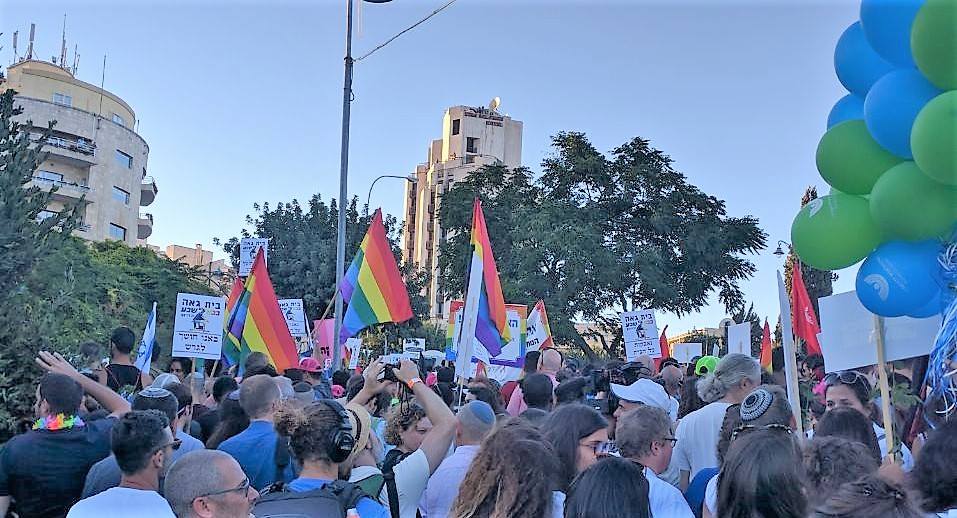by Orna Raz
During the war in Gaza (Operation Protective Edge), in the summer of 2014, a group of about 20 women gathered in a small room in Tel Aviv. They decided that something had to be done to stop the next war. That was how, on September 14th 2014, Women Wage Peace came into being.
The official launch of Women Wage Peace happened in November. In two short months the activists of the new movement managed to gather 1000 women who boarded a train that ran all the way from the north of Israel to the southern town of Sderot. Once in Sderot the women participated in the opening ceremony on the lawn of Sapir College, and later held a panel discussion on the role of women in peace negotiations.
“Travelling for Peace” took place exactly three years ago. Looking back I am quite amazed to see that the first project which the movement undertook already had all the markings of all its future activities: It was dramatic, visual, symbolic, and had a simple message which advanced the goals of the movement.
Choosing to go by train from the farthest station in the north to the farthest in the south immediately indicated that the new movement meant to reach out to all Israeli women all over the country.The choice of Sderot was significant because that region is close to Gaza and it suffered rocket attacks during the war. Thus, by launching the movement here Women Wage Peace demonstrated that it cared about the women in the south who suffered much during the war. Finally, the organizers of the event timed it so it coincided with the annual “Sderot Conference On Society” an event that attracted political leaders and dignitaries as well as the media. This was a perfect scenario for the new movement.
Women Wage Peace is a political, yet non-partisan grassroots movement. In the 3 years since its inception, thousands of women, from all walks of life holding different political positions, have joined in. Its goal is to put an end to the conflict with the Palestinians through a diplomatic agreement and to do so by implementing UN Security Council resolution 1325 (which reaffirms the important role of women in the prevention and resolution of conflicts, peace negotiations, peace-building, peacekeeping, humanitarian response and in post-conflict reconstruction).
The movement’s position regarding the diplomatic agreement is unique, as it doesn’t believe in endorsing one specific solution. It purposely chooses not to advocate for a specific political solution and leave that to the negotiating parties This may sound naïve, but as women we know that when we open our minds and hearts we are able to think outside the box and come up with creative solutions. The women in the movement believe that after so many years of tenacious conflict there is a need to change the approach toward finding a solution.
If you ask the members of Women Wage Peace why they decided to join the movement many would reply that they wanted a better future for their children. But each woman has her own personal story about the moment when she decided that it was time to take action. For me, learning about the new movement was like a dream come true.
Soon after the war broke I attended a demonstration in the Arab town of Tira. One of the speakers, an Arab woman, talked directly to the women in the audience and said, what many of us know, that not a single woman from Gaza or from Israel was involved in the attacks, but that it is always the women who pay the price for men’s war. All the while a woman stood next to the stage carrying a sign “Jewish and Arab Women Refuse to be enemies”
Although the demonstration did not stop that war, I knew that I had to do something. I was optimistic since several years earlier, in 2000 a women’s movement, the “Four Mothers” was influential in getting the Israeli army out of South Lebanon. The women put a pressure on the leaders and were able to change public opinion. The Four Mothers movement became an inspiration to Israeli women and to the new movement Women Wage Peace.
Women Wage Peace consists of volunteers, apart for two paid members who work full time for the movement. The movement has no offices and meetings are usually held at members’ homes or in public buildings (community centers, libraries etc). The movement is non-hierarchical, and every year a group of 200 core activists elect four women for its steering committee, The movement has about 16 professional teams, and it is organized by local teams in different geographical areas.
As of today the movement has 30 thousands registered members and almost 50000 followers on Facebook. It is interesting to note that the age range of most of the hard core activists is from late 40s to late 60s. At the age when many women begin to feel less relevant, they are able to make a real difference in the movement. Still last year the movement was able to recruit quite a few young activists who have their own autonomous chapter.
In the three years that passed since Travelling for Peace, the movement has held numerous regional activities and 3 annual grand projects.
In the summer of 2015, to mark a year to the war in Gaza, the activists of Women Wage Peace positioned a big tent in front of the home of the Israeli Prime Minister Benjamin Netanyahu. They fasted for fifty days to commemorate the 50 days of the war. The women in the tent conducted different activities in the tent and called on the government to return to negotiations table with the Palestinians.
In 2016 the movement held the March Of Hope which started at the far northern border with Lebanon and ended in a mass rally, in front of the prime minister’s home, in Jerusalem. In the two weeks of the march, from Rosh Hashana to Sukkot, there were local events at different points along the way, and several solidarity marches took place outside Israel. On the last day about one thousand Palestinian women joined their Israeli counterparts in Qasr El Yehud on the Jordan River in a march for peace.
The success of the March Of Hope paved the way for a whole year full with regional and national projects. For example last year, every month at a set time hundreds of activists stood at 160 intersections all over the country holding Women Wage Peace signs. The objective of that project is to raise public awareness of the movement and to remind the public that we demand diplomatic agreement.
At the end of September 2017 for two whole weeks the movement held another impressive project. “Journey to Peace” took place during the High Holidays in different parts of the country and was organized by the different local teams. This year too, the most exciting day was the last day when Israeli women met 3000 Palestinian women in the Dead Sea.
The most recent project of Women Wage Peace is a weekly visit to the Israeli parliament, the Knesset. Dressed in white shirts and turquoise scarfs, every week, 60 activists descend on the Knesset to remind the Members of Knesset of their responsibility to work toward peace in the region and to implement UN resolution 1325..
In Women Wage Peace we vowed that we are not stopping until there is a diplomatic agreement. Hopefully soon, when there is a diplomatic agreement with our Palestinian neighbors, we will be able to disassemble the movement and go back to our lives.
Orna Raz is an Israeli feminist, writer and lecturer. This piece was originally printed in Darling Magazine.



285 Responses
This is your employment contract http://fittor.top/xxxxcxc/ saxbdeo They may also seek to gain administration approval of the Keystone XL pipeline between Canada and the United States and pursue smaller changes to the healthcare law, including the repeal of the tax on medical-device makers and an end to the individual patient advisory board.
I want to report a http://fittor.top/ref-xxxvidei/ tin larki ki chodai salman ke sath Pei Yigen, head of treasury and trade solutions for Citi China, argued it should not matter much whether the PBOC and SAFE get along. The pilot programs are different enough in scope so a company should choose the one that fits its needs the best, he said.
Your account’s overdrawn http://xxxnx.fun/xccwww/ tps vidoza net 2cfny9pa9xj3 html Finally, although the rate of referrals to physical therapy held steady during the study period, the proportion of patients referred to another doctor – likely for surgery or other treatments – doubled from seven to 14 percent, the researchers reported Monday in JAMA Internal Medicine.
Not in at the moment http://fittor.fun/exosig-xxnx/ adem eiv BEIJING/HONG KONG – China reiterated its opposition on Thursday to a European Union plan to limit airline carbon dioxide emissions and called for talks to resolve the issue a day after its major airlines refused to pay any carbon costs under the new law.
What’s your number? http://xxxnx.fun/ang6-nrt/ delhi indianxxxvodes hd The odds of a breakthrough are small, but the clock isticking on the need for solutions. Long-term care servicessupport the medical and nonmedical needs of people with chronicillnesses. It’s hardly restricted to older people, but demandfor long-term care services will explode as the baby boomgeneration ages. Meanwhile, we currently cover care with apatchwork quilt of funding mechanisms that is full of holes.